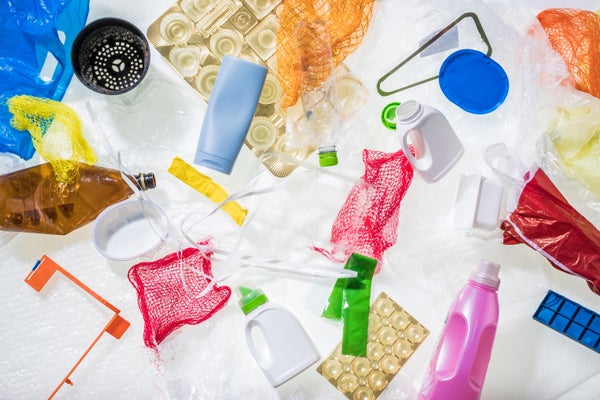Plastic pollution is recognized as being one of the major global environmental challenges today, with a worldwide reach that is affecting essential Earth systems such as the climate and biodiversity. As a result, in March the United Nations Environment Programme declared its intention to develop a treaty by 2024 to “end plastic pollution”. However, although the declaration lays out overall aims for reducing plastic pollution, it does not mention any specific policy measures (see go.nature.com/3rgujfc). An efficient and ambitious treaty has the potential to facilitate the much-needed transition to a circular plastic economy, and mark the beginning of a reduction in the rate of plastic pollution. But to achieve this, it is paramount that the new treaty does not become a doctrine for recycling at the expense of providing a legal foundation for reducing plastic consumption.
For many years, the transition to a circular plastic economy has been understood to require a combination of efforts, often summarized by the mantra ‘reduce, reuse, recycle’. The principles are based on the top three levels of the waste hierarchy, whereby reducing is better than reusing, which is, in turn, more favourable than recycling. In practice, however, attention has primarily been focused on recycling, owing to an assumption that a massive improvement in recycling rates will be crucial for the circular transition.
Adjust the focus
On supporting science journalism
If you're enjoying this article, consider supporting our award-winning journalism by subscribing. By purchasing a subscription you are helping to ensure the future of impactful stories about the discoveries and ideas shaping our world today.
A document published by the European Commission in 2018, outlining how the plastic economy should be transformed, serves as a good example of this tendency (see go.nature.com/3clrqdq). The word ‘recycle’ and its derivatives appear 144 times, whereas words rooted in ‘reuse’ and ‘reduce’ occur only 12 and 18 times (and most mentions of the latter relate to reducing environmental litter, not plastic consumption). Of the nine specific targets listed as part of the European Union’s ‘vision’ for a new plastics economy, seven relate exclusively to recycling.
The focus on recycling had two implications. First, it is likely to result in member states implementing measures to increase recycling—and therefore not actively working towards any reduction targets. Second, it could actually deter states from setting reduction targets because such targets could make it harder to meet recycling demands, owing to an overlap between the plastic that could easily be collected for recycling and that which could be reduced.
The idea of recycling being the optimal solution is built on the thinking that a near-perfect closed-loop system can be achieved, and that if materials are kept in the circular value chain we can use them indefinitely. This is unfortunately far from the truth. According to the Organisation for Economic Co-operation and Development, only 15% of plastic waste is collected for recycling, and, of that, 40% is discarded from the recycling process on account of its low quality. As a result, actual plastic recycling rates are as low as 9%.
Moreover, most plastic sent for recycling, especially that collected from households, is downcycled—that is, the recycled product is of a lower quality than the original—on account of its heterogeneous nature. To avoid any loss in quality during the recycling process, waste fractions must be kept uniform, with fractions typically consisting of single polymers without additives such as pigments. New and better recycling technologies will improve this, but it is unrealistic to expect a near-perfect system to be achieved in the near future.
Don’t create dependence
Massive investments in recycling infrastructure could lead to a ‘lock-in’ situation, whereby we build a sector with infrastructure that makes us dependent on the recycling of most plastics—even if that is not the optimal solution. Such a scenario has resulted in some countries making major investments in incineration plants that facilitate the continuous burning of waste to produce energy. In Denmark, where massive past investments were made in such plants, waste now needs to be imported to ensure that these incinerators meet their energy production targets.
It is therefore essential that the UN plastic treaty aims to not merely increase recycling rates, but also to reduce the consumption of both plastic and the other resources that plastic enables us to consume. It should be noted that there is also a need for the treaty to develop waste-handling systems in parts of the world where this is currently poorly managed, but that is not, in itself, a long-term remedy. The solution to ending plastic pollution—the resolution’s aim—lies in providing incentives to a transition that builds on reducing non-essential plastics use and making products that last for as long as possible.
Policymaking will be at the centre of this transition, and inspiration can be found in both prior experiences and current processes. Ireland, for example, was one of the first countries in Europe to put a levy on plastic bags. This policy resulted in a 90% drop in consumption and the generation of more than US$9 million for a green public fund. Meanwhile, the trend in EU policy is shifting slightly towards promoting better design and longer-lasting products. The new EU Ecodesign Directive, for example, will outline specific measures that could serve as an inspiration for how policies can promote sustainable production.
Such efforts are important steps in the transition to a circular plastic economy—and should guide the writers of the UN plastic treaty in their efforts. In the end, that treaty will become a key component in the circular transition of the plastic economy only if it guides policymakers to put in place far-sighted measures that make it worthwhile for manufacturers to make long-lasting products. That is the key to a sustainable plastic future.
This article is part of Nature Outlook: Circular Economy, an editorially independent supplement produced with financial support from Google. About this content.
